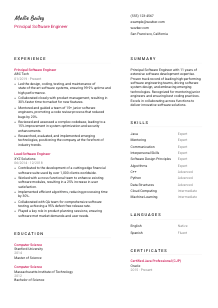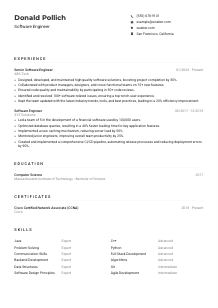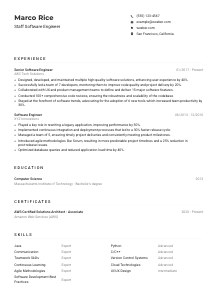Principal Software Engineer Resume Example
Leading software squads, but your resume feels like a rogue line of code? Refactor it with this Principal Software Engineer resume example, architected using Wozber free resume builder. Discover how you can showcase your technical leadership in line with company expectations, making your career journey bug-free and scalable as your best programs!

How to write a Principal Software Engineer Resume?
Hello, aspiring Principal Software Engineer! In the realm of software development, standing out in a stack of resumes isn't just a goal—it's a necessity. Your resume isn't merely a document; it's a reflection of your coding prowess, leadership skills, and vision for technological innovation. Harness the power of the Wozber free resume builder, and let's embark on a transformative journey to tailor your resume with pinpoint accuracy to your dream Principal Software Engineer role.
Ready to compile your future in the tech world? Scroll down, and let's get started on engineering your career masterpiece.
Personal Details
Your Personal Details section is more than a formality; it's the equivalent of opening your GitHub profile with well-commented repositories. Here's how you personalize this section to align precisely with the Principal Software Engineer position, ensuring it speaks directly to the hiring managers.
1. Name as Your Brand
Your name is akin to a trusted software brand—make it prominent. Opt for a clear, professional font, and don't shy away from making it slightly larger. Your name is the method signature of your career code—make sure it's unmissable.
2. State Your Role
Directly below your name, position the title you're aiming for: Principal Software Engineer. This aligns your resume's purpose with the hiring manager's expectation from the get-go. It's like declaring your function's intent upfront in your code—clean and straightforward.
3. Essential Contact Info
Include your phone and a professional email address. Imagine this as setting up your callback functions for prospective employers to reach out easily—ensure there are no typos in your 'function calls'!
4. Geolocation Match
The job specifies 'Must be located in San Francisco, California.' Highlight your San Francisco base upfront to meet one of the key requirements head-on. Think of this as matching a crucial parameter in a software spec.
5. Online Portfolio
Add a link to your professional profile or portfolio website. This should be your GitHub or LinkedIn, showcasing your repositories or professional network. It acts as a hyperlinked comment in your resume's code, leading to more about your projects and contributions.
Takeaway
Consider the Personal Details section as setting up your development environment before coding. It's foundational, ensuring everything that follows aligns perfectly with the role of a Principal Software Engineer. You're now ready to write the logic of your career narrative.





Experience
The Experience section is where you lay out the architecture of your career, showcasing projects and leadership akin to a well-organized codebase. Let's engineer this section to reflect your suitability for the Principal Software Engineer position, highlighting your technical and leadership skills.
- Led the design, coding, testing, and maintenance of state‑of‑the‑art software systems, ensuring 99.9% uptime and high performance.
- Collaborated closely with product management, resulting in 30% faster time‑to‑market for new features.
- Mentored and guided a team of 15+ junior software engineers, promoting a code review process that reduced bugs by 20%.
- Reviewed and assessed a complex codebase, leading to a 15% improvement in system optimization and security enhancements.
- Researched, evaluated, and implemented emerging technologies, positioning the company at the forefront of industry trends.
- Contributed to the development of a cutting‑edge financial software suite used by over 1,000 clients worldwide.
- Worked with a cross‑functional team to enhance existing software modules, resulting in a 25% increase in user satisfaction.
- Implemented efficient algorithms, reducing processing time by 30%.
- Collaborated with QA team for comprehensive software testing, achieving a 95% defect‑free release rate.
- Played a key role in product planning sessions, ensuring software met market demands and user needs.
1. Decode the Spec
Begin with a meticulous review of the job description. Highlight keywords and requirements such as 'Lead the design, coding, testing, and maintenance of software systems.' Your past roles should reflect these elements closely.
2. Methodology Structure
Organize your experience in a chronological format, with the most recent position at the top. For each role, list your title, the company's name, and your tenure. Think of this as defining your classes and methods in your career's source code.
3. Bullet Your Impact
Under each job, list accomplishments that mirror the responsibilities and achievements stated in the job description. This includes mentoring junior engineers or improving system performance. Think of these bullets as the comments in your code explaining the impact of each function.
4. Quantify with Data
Wherever possible, quantify your achievements. Did your leadership increase system uptime to 99.9%? Numbers are compelling evidence of your impact, much like metrics in performance testing.
5. Relevance is Key
Stay laser-focused on experiences that relate directly to a Principal Software Engineer's duties. Lead with technical achievements and leadership experiences, trimming any irrelevant details. It's about optimizing your resume's 'code' for readability and performance.
Takeaway
Your Experience section should now highlight your technical excellence and leadership in past roles, mirroring the responsibilities of a Principal Software Engineer. It's your career's changelog, evidencing version upgrades in skills and responsibilities. On to your academic background!
Education
In the ever-evolving tech landscape, your educational foundation sets you apart. Here's how to construct your Education section to reflect the depth of your academic journey, supporting your fit for the intricate role of Principal Software Engineer.
1. Identify Core Requirements
Pinpoint the role's educational prerequisites—'Bachelor's degree in Computer Science, Engineering, or related field; Master's degree preferred.' Ensure your highest level of relevant education matches these requirements.
2. Structure for Clarity
Present this section succinctly. List the degree, field of study, institution, and graduation year. It's like the docstring for a complex function, providing essential information at a glance.
3. Match Your Credentials
Ensure your listed degrees resonate with the job's criteria. Highlighting a 'Master of Science in Computer Science' directly matches the preferred qualification, positioning you as an ideal candidate.
4. Coursework and Projects
Though not necessary for seasoned professionals, early-career engineers can benefit from listing relevant courses or projects. It showcases a proactive approach to acquiring skills pertinent to the role.
5. Additional Achievements
If you graduated with honors or partook in relevant extracurriculars (think coding competitions or tech clubs), briefly mention these. It adds depth to your academic profile, akin to adding features to a software release.
Takeaway
With your Education section finely tuned, you've laid a solid academic groundwork that aligns with the job requirements. It's the underlying framework supporting your technical and leadership skills. Next, let's enhance your resume with certifications.
Certificates
Certifications are like badges of honor, symbolizing your dedication to honing your craft. They are pivotal in showcasing your specialized skills and continuous learning attitude, which are invaluable for a Principal Software Engineer.
1. Align with Job Specs
Review the job description for any explicit certification requirements. While this specific job description for Principal Software Engineer didn't list certifications, including relevant ones like 'Certified Java Professional' from Oracle highlights your expertise in a primary programming language.
2. Quality Over Quantity
List certifications that strengthen your candidacy for the role. Aim for relevance and recency, proving your skills are up-to-date and in line with industry standards.
3. Date Relevance
Include dates to show the currency of your certifications. This demonstrates your ongoing commitment to professional development, much like maintaining documentation for software updates.
4. Continuous Learning
The tech field is always evolving, so show that you are too. Regular updating of your certifications section reflects a mindset of growth and adaptability, key traits for a Principal Software Engineer.
Takeaway
With your certifications neatly documented, your resume now reflects a profile of continuous improvement and specialized expertise. It's equivalent to showcasing the latest and most stable version of a software product. Time to highlight the programming languages you speak.
Skills
The Skills section is your quick-reference guide, outlining the programming languages, frameworks, and soft skills you command. For a Principal Software Engineer, this section must reflect both your technical mastery and your ability to lead.
1. Extract from the Job Description
Identify both the explicitly mentioned and the tacit skills needed for the role. Skills like 'strong understanding of software design principles' and 'excellent communication' are your keywords.
2. Match Your Skillset
Reflect on your competencies that align with the job requirements. For instance, if the job listing details proficiency in Java, C++, and Python, rate your expertise in these languages honestly.
3. Organize for Impact
Prioritize the skills that are most relevant to the role. Lead with your technical skills, followed by leadership and interpersonal abilities. This organization mimics the structure of a well-documented API, guiding the reader with ease.
Takeaway
By meticulously mapping your skills to the job description, you've created a concise overview of your professional aptitudes. It's a testament to your readiness to tackle the challenges of a Principal Software Engineer role. Up next, let's articulate your multilingual proficiency.
Languages
In our global tech environment, the ability to communicate in multiple languages can significantly enhance your professional profile. While not always a requirement, displaying your linguistic skills can provide a competitive edge.
1. Job Language Requirements
First, note any language requirements or preferences stated in the job description. For our Principal Software Engineer position, 'Must be able to operate effectively in English.'
2. Prioritize Relevant Languages
List English at the top, categorizing your proficiency level accurately. Including additional languages, such as Spanish, demonstrates cultural insight and the potential to collaborate in a diverse workplace.
3. Include Additional Languages
Mention other languages you're proficient in. This can be particularly appealing for roles requiring interaction with global teams or clients.
4. Honest Proficiency Levels
Clearly state your level of proficiency in each language, using terms like 'Native', 'Fluent', 'Intermediate', and 'Basic'. It's akin to specifying whether you're proficient, familiar, or a novice in programming languages.
5. Assess the Role's Global Scope
For roles with a global or multicultural aspect, fluency in multiple languages could be a significant advantage. It showcases your ability to navigate and contribute to a global tech ecosystem.
Takeaway
Your languages section now eloquently conveys your ability to communicate and collaborate in a multifaceted tech world. It's the soft skills equivalent of being proficient in multiple programming languages - a valuable asset for any Principal Software Engineer. It's time to refine your professional summary.
Summary
The Summary is your resume's 'Hello, World!' moment—a succinct pitch that encapsulates your professional essence. A well-crafted summary for a Principal Software Engineer should echo the role's complexity and your readiness to lead in the tech space.
1. Decode the Role
Start by internalizing the job description. Understand what makes this role tick—its technical needs, leadership demands, and the organizational impact you're expected to deliver.
2. Introduce Your Framework
Begin with a brief introduction that highlights your professional standing—'with 11 years of extensive software development expertise.' This sets the stage, providing a clear snapshot of your experience level.
3. Highlight Your Modules
Showcase your technical skills and leadership capabilities. Mention your role in driving software design, mentoring junior engineers, and staying ahead of technology trends. Each point should resonate with the job requirements.
4. Optimize for Impact
Keep the summary concise and focused. Aim for a powerful 3-5 lines that encapsulate your suitability for the role, making it as compelling as an optimized algorithm.
Takeaway
The Summary section is now your personal tagline, previewing a principal-level talent ready to elevate software engineering to new heights. With this, your resume is nearly compiled and ready to function flawlessly in the job market. Let's initiate the final build.
Committing Your Career Code
Congratulations on successfully navigating through the intricate process of crafting a tailored, ATS-compliant resume for the Principal Software Engineer role. With every section refined and optimized, your resume is now a powerful tool, poised to communicate your unmatched expertise and potential to prospective employers. Let this be your launchpad to a role that challenges, inspires, and leverages your talent to its fullest.
The tech world is vast, and with your skills, the possibilities are limitless. Compile your achievements, debug your career path, and let your journey to becoming a principal software engineer begin.

- Bachelor's degree in Computer Science, Engineering, or related field;
- Master's degree preferred.
- Minimum 10 years of experience in software development with expertise in multiple programming languages such as Java, C++, or Python.
- Proven track record of leading and mentoring software engineering teams.
- Strong understanding of software design principles, data structures, and algorithms.
- Excellent communication and interpersonal skills, with the ability to work collaboratively in a cross-functional environment.
- Must be able to operate effectively in English.
- Must be located in San Francisco, California.
- Lead the design, coding, testing, and maintenance of software systems ensuring high quality and performance.
- Collaborate closely with product management and other stakeholders to define and deliver on product requirements.
- Mentor and guide junior software engineers, promoting best practices and providing technical expertise.
- Regularly review and assess codebase for optimization, performance improvements, and security vulnerabilities.
- Research and evaluate emerging technologies to drive innovative solutions and stay ahead of industry trends.















